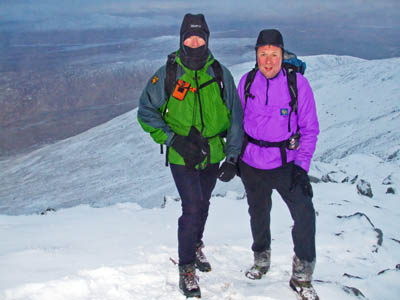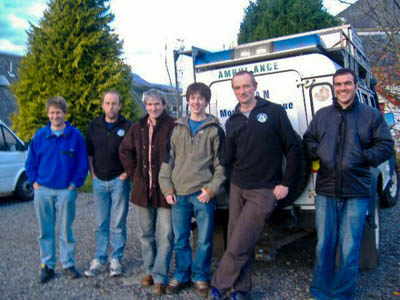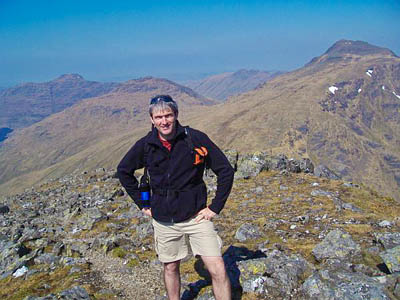
Michael Tunney returns to Beinn Achaladair with walking colleague John
It was to be a fairly straightforward day: a seasoned munro-bagger and his son ticking off two more peaks in the quest to complete the full list in a period of five years.
Six days later, Michael Tunney awoke surrounded by the beeping equipment of a hospital intensive-care unit, unable to move and with little idea of why he was there. Then slowly, the recollection of the events which put him face-to-face with death drifted back along with his consciousness.
Michael’s tale is one that should strike a chord with every hillwalker and peakbagger. A moment’s inattention led to disaster and a near-fatal fall from a Scottish mountainside.
Edward Whymper, the renowned Victorian alpinist, wrote: “Climb if you will, but remember that courage and strength are nought without prudence, and that a momentary negligence may destroy the happiness of a lifetime. Do nothing in haste; look well to each step; and from the beginning think what may be the end.”
Michael Tunney’s end nearly came on a November afternoon in 2006, when a slip on an icy patch on the 1,038m (3,406ft) Beinn Achaladair sent him tumbling down the mountainside. The Helensburgh police officer ended in a heap covered in blood from a gashed head, with his arm broken, hip fractured, seven ribs broken and, though he didn’t realise it at the time, with a broken neck.
A major rescue operation began soon after his tumble, as his 16-year-old son, also called Michael, dialled 999 from his mobile phone on the mountainside near Bridge of Orchy and told the rescuers of his father ‘s plight.
In his efforts to get to his father 60m (200ft) below, Michael Junior also fell, breaking bones in his hand and knocking himself out.
In three months time, Michael Senior will attempt to pay back his rescuers, the volunteers of the Oban Mountain Rescue Team and their Arrochar colleagues.
He will attempt the nine Scottish 4,000-footers – all the Highland munros over 4,000ft – and 14 other munros en route. Cash raised by his charity effort will go to the two mountain rescue teams and the Northern Police Convalescent Home, without whose work he might not have recovered sufficiently to take to the hills again.
The route will involve 30,000ft of ascent – more than the height of Everest – and should take 10 days if all goes to plan.
Michael tells the story of that fateful day: “The views were stunning [from the top of Beinn Achaladair], but we didn’t linger, as the gusts had really picked up and were picking up the light snow covering.
“We headed down into more sheltered ground and had some food and a hot drink. By this time, we had put on warmer clothing, a decision that later would become lifesaving. Suitably refreshed, we started to head towards Beinn a’Chreachain. It was at this point, that the day changed course which almost proved fatal.
“Michael complained of pain in his ankle. He had recently completed the West Highland Way, but with some discomfort. There was still a fair bit to go, but I gave him the option, and at the time, he made the correct decision not to continue.
“Whether I made the next decision correctly is something that I still think about, even though there is nothing I can do to change anything. Heading back up and over Beinn Achaladair was out of the question and I felt that the most direct route off the mountain, with a shorter distance to the car would be the best for Michael’s ankle. However, I didn’t plan for such a rapid descent. We headed towards the forest and the Water of Tulla. Although the ground was steep, there wasn’t much descent to cope with to reach easier terrain.
“We had left much of the strong gusts behind and things should have been easier at this point.
“But in an instant, it was a turn of foot on some ice that almost proved my undoing. I had stopped and turned to see what Michael was doing when my heel slipped slightly. It was enough to spin me and to instantly lose my bearing. Pack-side ended up over the slope and I lost my balance.
“I hit the ground hard but couldn’t stop, just continued to pick up speed and bounce down the mountainside, colliding with several rocks on the way. I’ve been asked many times if had lost consciousness at any point. Fortunately I didn’t. Although this meant that I remember every hard contact with rock, and there were quite a few, I was able to regain some composure once I had stopped. The downside was that I was very aware as soon as my arm broke.
“It’s strange what goes through the mind. My first thought was: ‘I’m supposed to be going out for dinner tonight’. Weird! But reality soon kicked in especially when I heard my son shouting. Thankfully I was able to answer him.
“I can only imagine the horror in his mind when he saw me fall and the relief when I answered him. To his credit, he phoned 999 straight away. Although he had just seen me take the most horrendous fall and that he wasn’t completely sure of his location, he got things moving with the description that he was able to pass.
“It was then that some panic set in and he lost his footing coming down to me. He broke a couple of bones in his hand and bumped his head, which caused him to lose consciousness, though thankfully for a short time. One he reached me though, I’m sure I wasn’t a pretty sight. Although my jacket had stayed intact, I knew that my arm was in a bad way. I was also aware of a gash on the top of my head and a sharp pain in my back. Michael appeared to be in one piece and not fazed by his fall, although I’m sure that he was trying to be brave for me as well. I would think that he realised that I was in the shit!
“I had lost my pack in the fall and we had no idea where it was. Later, when I was able to look back at things, I could see a chain of events that were all positive to me staying alive.
“The first was the decision to take the insulating gear out of the pack and put it on. The second was to carry two mobile phones with different networks – although they both worked – and to keep them in our jackets. It’s something I’ve always done. But getting signals on the phones was to be the most crucial.
“I was able to phone 999 and speak to the operator. I even got the pronunciations correct, although I failed the grid reference test! The most surreal moment was being asked for a postcode. I vaguely remember an expletive at that point.
“Once the call had been made it was time to take stock of our situation. I knew the weather was expected to worsen later in the evening, when we’d planned to be miles away, and I knew that we’d be glad of the warm gear. I also had some chocolate in my jacket and we had plenty of battery life on the phones. There was no possibility of self-rescue so we had to sit tight.

The Tunneys are reunited with members of the Oban MRT at the Bridge of Orchy Hotel
“The pain in my back was excruciating. I believed the pain was due to being wedged against some rocks, so I had told Michael that I needed to move. There was no way that I could have stayed in that position for hours. Michael was set against it. I was wedged slightly onto my left side, so I tried to move with my right leg. When nothing happened, I knew that something was badly wrong with the leg as well as the arm. I decided to sit tight.
“Over the next few hours, the police phoned back and Michael replied to a text from his mum. I’m in trouble now, I told him.
“Darkness was closing in and the wind had picked up. The cold stopped the bleeding from my head and I was in less pain and discomfort, but I was also acutely aware what else it was doing to me. I kept talking and wiggling things.
“We talked about anything and everything. Self-determination and the will to survive is an amazingly powerful emotion, although I would rather not have to experience it again. I knew that I was fading but, foremost because of Michael, I knew that I had to keep going. We could see cars on the A82 Fort William road. It was so surreal to see how close they were.
“After what seemed like an eternity, we could see the head torches of the mountain rescue team approaching from the road. While this was a very heartening sight, the sound of a helicopter approaching was a sound and emotional experience that I will never forget.
“By this time, the wind was as bad as it had been on the summit and it had started to rain. We were so close to being rescued and I was really struggling. Michael was doing so well, but he was beginning to feel the strain and probably the effect of his injury as well. The police were phoning back and I had to tell Michael not to get too upset with them. It became obvious that the helicopter hadn’t picked us out. Even worse the MRT was heading away from us.

Michael Tunney on Beinn Ime getting back to fitness
“To hear Michael when the helicopter flew off was heartbreaking and he was very difficult to reassure.
“What we learned some time after, was that the helicopter didn’t have infra-red – it does now – and had gone to pick up the Arrochar MRT.
“They were dropped off higher up and came down in the direction that we had taken. The Oban team had been sent to wrong corrie and it was only by some foresight from the helicopter crew that saved the day. The rescuers turned off their headtorches and Michael was told to light up the phones. On the helicopter’s return, they immediately picked us out. The MRTs were with us soon after that. I remember the rustling of a survival tent and swearing as I was moved.
“The last thing I remember is one of the guys speaking to Michael, then, I don’t remember anything for five days. I’ve been told that once I knew that he was safe, my mind and body just relaxed. I was flown to the Southern General Hospital in Glasgow and was critical throughout the night.
“My family were told to prepare for the worst. My rescuers didn’t think I’d make it either.”
He did make it, and has followed a gruelling regime to enable him to get back to hillwalking.
His greatest test will come in May, when he sets off from Aviemore to tackle the 103-mile route to Glen Nevis and Fort William, taking in Cairn Gorm, Ben Macdui and Ben Nevis, among others. He will be camping and using bothies along the route.
You can read more about Michael’s fateful day, his rescue, his recovery and his plans to raise money for the people that helped him on his blog. You can also see details of how to contribute to the appeal.
His 4,000-footer quest begins on 8 May.
katherine McCudden
10 March 2009Please donate for the Michael Tunney appeal